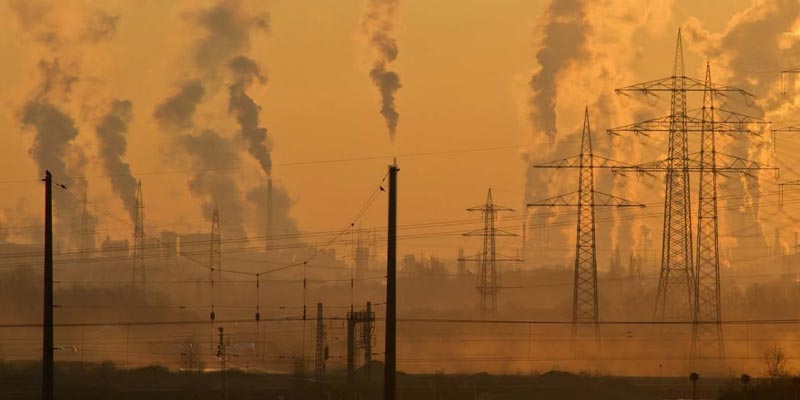- World
- Sep 25
How CO2 concentration drives global climate change?
If the Sustainable Development Goals (SDGs) are to be achieved by the 2030 target, the risks posed by human-induced climate change must be understood and addressed. The World Meteorological Organization (WMO) has published a new report on ‘Climate Indicators and Sustainable Development: Demonstrating the Interconnections’.
The report demonstrates the connections between the global climate and the SDGs, which go far beyond SDG 13 for climate action.
It highlights seven climate indicators whose impacts span the SDGs:
• Carbon dioxide concentration
• Global mean surface temperature
• Ocean acidification
• Ocean heat content
• Sea-ice extent
• Glacier mass balance
• Sea-level rise.
Because CO2 concentration drives global climate change, it is indirectly responsible for risks related to the other climate indicators and nearly every single SDG. Therefore, reducing carbon emissions is one of the most effective and necessary climate-related actions for achieving the SDGs.
Effects of rising atmospheric concentrations of CO2
• Carbon dioxide (CO2) is the primary greenhouse gas from anthropogenic emissions. It comes from burning fossil fuels (eg: coal, oil and natural gas) and land-use changes, such as deforestation. Additionally, thawing permafrost and wetland degradation further increase CO2 emissions.
• The rise in atmospheric CO2 concentration contributes to the greenhouse effect. The greenhouse effect occurs when gases such as CO2 absorb and emit energy, trapping it in the atmosphere.
• Greenhouse gases are major drivers of climate change and critical contributors to radiative forcing, which is defined by the Intergovernmental Panel on Climate Change (IPCC) as a change in the balance of incoming and outgoing energy in the Earth-atmosphere system.
• Although the greenhouse effect naturally occurs and is necessary for life on Earth, when enhanced through human activity, it accelerates planetary warming. Rising CO2 concentration and associated rising global temperatures, when unchecked, may both signal the limitations of the efficacy of efforts to combat climate change and put at risk efforts to limit its impacts to (SDG 13).
• Additionally, CO2 concentration is rising in both the ocean and the atmosphere. Rising CO2 in water causes ocean acidification, directly affecting SDG indicator 14.3.1 and indirectly affecting others.
• As atmospheric concentrations increase, photosynthesis processes accelerate, producing agricultural yields in less time. This can result in a reduction of certain grain protein and nutrient concentrations, a process known as growth dilution.
• Reductions in nutrient content affect food security, specifically SDG indicator 2.1.2.
• Recent studies have demonstrated that there may be direct health risks associated with increased exposure to high levels of atmospheric CO2, thus threatening SDG indicators 3.4.1 and 3.9.1.
• Carbon dioxide alone is responsible for about 82 per cent of the increase in radiative forcing over the past decade.
What is radiative forcing?
When energy from the sun reaches the Earth, the planet absorbs some of this energy and radiates the rest back to space as heat. The Earth’s surface temperature depends on this balance between incoming and outgoing energy. A shift in the energy balance causes the Earth’s average temperature to become warmer or cooler, leading to a variety of other changes in the lower atmosphere, on land, and in the oceans.
These changes are measured by the amount of warming or cooling they can produce, which is called “radiative forcing.” Changes that have a warming effect are called “positive” forcing, while changes that have a cooling effect are called “negative” forcing. When positive and negative forces are out of balance, the result is a change in the Earth’s average surface temperature.
Changes in greenhouse gas concentrations in the atmosphere affect radiative forcing. Greenhouse gases absorb energy that radiates upward from the Earth’s surface, re-emitting heat to the lower atmosphere and warming the Earth’s surface. Human activities have led to increased concentrations of greenhouse gases that can remain in the atmosphere for decades, centuries, or longer, so the corresponding warming effects will last for a long time.
Ocean acidification
• Approximately 25-30 per cent of all CO2 emissions are absorbed by the ocean. When CO2 dissolves in water, it turns into acid ions (H2CO3 and HCO3), which acidify the ocean.
• During the industrial era, ocean surface pH declined from 8.2 to below 8.1 as a result of an increase in anthropogenic CO2 emissions. This decline corresponds to an increase in oceanic acidity of about 30 per cent.
• In recent decades, ocean acidification has been occurring 100 times faster than during the past 55 million years.
• Ocean acidification is linked to a decrease in carbonate ion concentrations, which are necessary for marine organisms, such as mussels, crustaceans and corals, to form shells and skeletal material.
• Therefore, ocean acidification can affect lower trophic levels and food sources for marine life, potentially resulting in large shifts in marine species which could significantly disturb the livelihoods of fisherfolk, fishing Industry and ocean-related services.
• In recent years, the dangers of ocean acidification have received growing attention from the international community. In 2017, a new SDG indicator (14.3.1) was added. Average marine acidity (pH) is measured and facilitated by the Global Ocean Acidification Observing Network, whose membership has now surpassed 100 countries.
• The impact on coral reefs is especially important. Coral reefs not only serve as one of the most biodiverse ecosystems in the world, but also provide essential shoreline protection in case of high waves or storm surge and serve as habitat for many important shellfish and other invertebrates. Thus, coral reefs are extremely susceptible to climate change and form a nature-based solution to combat the impacts of climate change.
Manorama Yearbook app is now available on Google Play Store and iOS App Store



